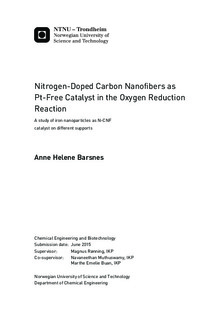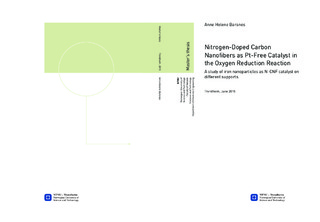| dc.contributor.advisor | Rønning, Magnus | |
| dc.contributor.advisor | Muthuswamy, Navaneethan | |
| dc.contributor.advisor | Buan, Marthe Emelie | |
| dc.contributor.author | Barsnes, Anne Helene | |
| dc.date.accessioned | 2015-10-06T07:36:51Z | |
| dc.date.available | 2015-10-06T07:36:51Z | |
| dc.date.created | 2015-06-08 | |
| dc.date.issued | 2015 | |
| dc.identifier | ntnudaim:12879 | |
| dc.identifier.uri | http://hdl.handle.net/11250/2351668 | |
| dc.description.abstract | A new approach was tested as nitrogen-doped carbon nanofibers (N-CNFs) were synthesized by using uniformly sized iron nanoparticles (FeNPs) on two different support as their growth catalyst. The N-CNFs are designed as a new catalyst for the oxygen reduction reaction (ORR) in a fuel cell. The aim was to establish working methods for a more homogeneous system which would give the possibility to study the effect of different parameters in-depth in future work.
Different samples of FeNPs were first produced in order to achieve the largest possible size with a homogenous distribution. The N-CNFs were then grown by utilizing the chemical vapor deposition method for 24 h. Both FeNPs and iron nitrate were used to impregnate two samples each with expanded graphite and vulcan carbon as their support. Scanning transmission electron microscopy (S(T)EM) was used to confirm the presence of N-CNFs and determine their structure, whereas x-ray photoelectron spectroscopy was used to confirm the incorporation of nitrogen. Finally, the ORR potential and the reduction pathway were determined by a three-electrode system to be between 0.88 V and 0.92 V for all samples. The system contained a reversible hydrogen electrode as a reference electrode and platinum foil as counter electrode.
Despite the uniform starting system, all samples exhibit great diversity of both N-CNFs structure and size. The most abundant structures were bamboo, fishbone and multi-walled carbon nanotubes. FeNPs impregnated on vulcan carbon (200Vu24h) exhibited both the highest activity and onset potential towards the ORR compared to the other samples. This is attributed to the relative short N-CNFs with bamboo structure and high surface area. The results also indicate that there is no correlation between neither the amount of nitrogen nor amount of quaternary-N and pyridinic-N and the activity above a certain nitrogen amount. | |
| dc.language | eng | |
| dc.publisher | NTNU | |
| dc.subject | Industriell kjemi og bioteknologi, Katalyse og petrokjemi | |
| dc.title | Nitrogen-Doped Carbon Nanofibers as Pt-Free Catalyst in the Oxygen Reduction Reaction - A study of iron nanoparticles as N-CNF catalyst on different supports | |
| dc.type | Master thesis | |
| dc.source.pagenumber | 151 | |

